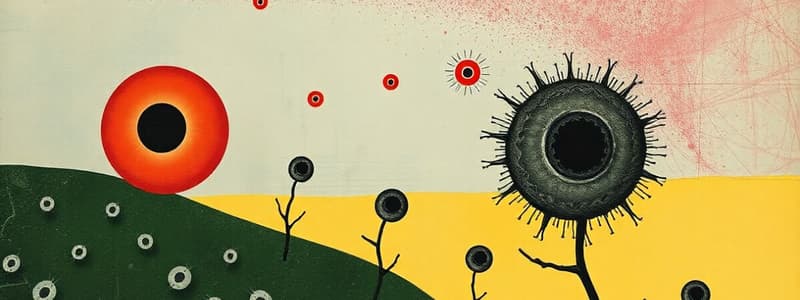Podcast
Questions and Answers
Which of the following is NOT a basic function of cells?
Which of the following is NOT a basic function of cells?
- Photosynthesis (correct)
- Obtaining nutrients
- Maintaining shape
- Disposing of wastes
Which cell type secretes protein for fibers?
Which cell type secretes protein for fibers?
- Macrophage
- Erythrocyte
- Fibroblast (correct)
- Neuron
Who is credited with observing that all organisms are made of cells?
Who is credited with observing that all organisms are made of cells?
- Theodor Schwann
- Rudolf Virchow
- Antonie van Leeuwenhoek
- Robert Hooke (correct)
What is the outer boundary of a cell called?
What is the outer boundary of a cell called?
Where is the DNA located within a cell?
Where is the DNA located within a cell?
Which of the following nucleotide bases is NOT found in DNA?
Which of the following nucleotide bases is NOT found in DNA?
Which organelle is responsible for ATP production?
Which organelle is responsible for ATP production?
During which phase of the cell cycle is DNA replicated?
During which phase of the cell cycle is DNA replicated?
Flashcards
What are cells?
What are cells?
Cells are the smallest living units capable of performing basic life functions.
Plasma Membrane
Plasma Membrane
The outer barrier of the cell, controlling what enters and exits.
Cytoplasm
Cytoplasm
Jelly-like substance within the cell containing organelles.
Nucleus
Nucleus
Signup and view all the flashcards
Ribosomes
Ribosomes
Signup and view all the flashcards
Endoplasmic Reticulum (ER)
Endoplasmic Reticulum (ER)
Signup and view all the flashcards
Mitochondria
Mitochondria
Signup and view all the flashcards
Interphase
Interphase
Signup and view all the flashcards
Study Notes
- Cells are the smallest living units, performing functions such as obtaining nutrients, making molecules, disposing of wastes, maintaining shape, and replicating.
- Specialized functions of cells are related to their shape and the arrangement of organelles within them.
Cellular Diversity
- Fibroblasts connect body parts by secreting protein for fibers.
- Epithelial cells are shaped to maximize packing.
- Erythrocytes have a concave shape to enhance gas uptake.
- Fat cells store nutrients and have a large fat droplet shape.
- Macrophages fight disease by moving to infection sites.
- Skeletal and smooth muscle cells facilitate movement, are elongated, and filled with contractile proteins like actin and myosin.
- Neurons gather information with long processes for communication.
- Sperm cells are reproductive cells with long tails for fertilization.
Cell Theory
- All organisms are made of cells (Robert Hooke, 1665).
- The cell is the basic unit of all organisms (Theodor Schwann, 1839).
- All cells arise from pre-existing cells (Rudolf Virchow, 1858).
Cellular Components
- The plasma membrane is the outer boundary of the cell.
- The cytoplasm contains organelles within the cell.
- The nucleus is the control center for cellular activities.
Membrane Structure
- The fluid mosaic model describes the structure of the plasma membrane.
- Integral proteins are embedded in the lipid bilayer.
- Peripheral proteins are attached to the membrane surface.
- The membrane functions as a barrier against external substances.
- The membrane contains receptors for signaling molecules.
- The membrane is selectively permeable, controlling substance entry and exit.
Cytoplasm and Organelles
- The cytoplasm is a jelly-like fluid that houses organelles.
- DNA directs activities in the nucleus.
- The nuclear envelope contains pores for molecule transport.
- The nucleolus, located in the nucleus, is responsible for ribosome assembly.
Molecular Structure of DNA
- DNA is structured as a double helix made of nucleotides A, T, C, and G.
- DNA and proteins form chromatin, containing nucleosomes.
Limitations on Cell Size
- Cellular size is limited by the surface area-to-volume ratio.
- Larger cells struggle with nutrient intake and waste removal.
Cytoplasmic Organelles
- Ribosomes are the sites of protein synthesis.
- The endoplasmic reticulum (rough and smooth) synthesizes and transports proteins and lipids.
- The Golgi apparatus is responsible for packaging and distribution of proteins.
- Mitochondria produce energy in the form of ATP.
- Lysosomes contain digestive enzymes for waste removal.
- Peroxisomes break down fatty acids and toxins.
- The cytoskeleton provides structural support.
- Cytoplasmic inclusions are temporary structures, such as lipid droplets.
The Cell Life Cycle
- Interphase (G1, S, G2) prepares the cell for division, including DNA replication.
- M Phase includes mitosis (nuclear division) and cytokinesis (cytoplasm division).
Mitosis Phases
- Prophase: Chromatin condenses, and the spindle forms.
- Metaphase: Chromosomes align in the center of the cell.
- Anaphase: Chromatids separate.
- Telophase: Chromosomes de-condense, and the nuclear envelope reforms.
Membrane Transport Mechanisms
- Passive transport requires no energy and moves substances down the concentration gradient. Examples are diffusion, and osmosis.
- Active transport requires energy to move substances against the concentration gradient.
- Endocytosis brings materials into the cell. Examples are phagocytosis, and pinocytosis.
- Exocytosis exports materials out of the cell.
Aging and Cell Function
- The free radical theory suggests aging is due to damage from metabolism.
- The mitochondrial theory suggests a decrease in energy production affects cell health during aging.
- The genetic theory suggests cell division limits aging due to telomeres.
Studying That Suits You
Use AI to generate personalized quizzes and flashcards to suit your learning preferences.
Description
Cells are the fundamental units of life, carrying out essential functions. Cell specialization is closely tied to their unique shapes. Key components of cell theory include the idea that cells form the basic building blocks of all living organisms.




